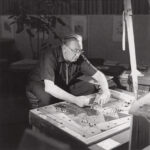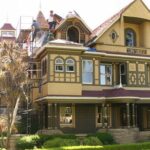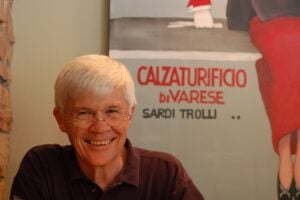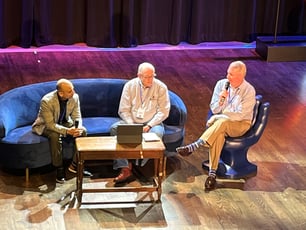Rebels of Construction—The Revolutionary Ideas of Buckminster Fuller
"Hailed as 'one of the greatest minds of our times,' R. Buckminster Fuller was renowned for his comprehensive perspective on the world's problems. For more than five decades, he developed pioneering solutions that reflected his commitment to the potential of innovative design to create technology that does "more with less" and thereby improves human lives.” - The Estate of R. Buckminster Fuller
Anyone described as a “futurist” is bound to be a rebel in some fashion. Our blog series, Rebels of Construction would be incomplete without an analysis of Buckminster Fuller.
Who Was Buckminster Fuller?
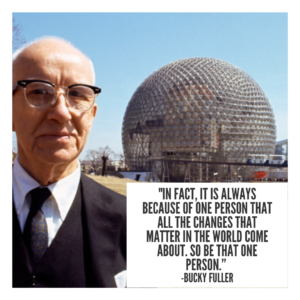 Buckminster Fuller (July 12, 1895-July 1, 1983)
Buckminster Fuller (July 12, 1895-July 1, 1983)There aren’t many who are the jack of all trades and the master of most. But revolutionary philosopher, scientist, inventor, and architect, R. Buckminster Fuller, certainly was. It’s nearly impossible to put a label on Bucky - as he liked to be called - because he was ingrained in so many different fields that the aforementioned listing barely scratches the surface of his accomplishments, acknowledgments, and expertise.
Bucky recalls taking his first daughter to the park in Chicago and airplanes—then rare—would fly over and he thought, “the impossible is now possible.” It is a philosophy we can say Bucky ascribed to throughout his life. One of the pioneers of sustainability, Bucky said his “main undertaking” was to “reorganize the environment of men by which then greater numbers of men can prosper” and he did that by designing and inventing structures, vehicles, and machines that were efficient and affordable in hopes that, as we would say now, everyone could live their best life.
Born on July 12, 1895, in Milton, Massachusetts into a family that promoted individualism, activism, and public service, Bucky drew a lot of influence from his great aunt, Margaret Fuller who was an author, women’s rights activist (she was the first woman allowed access to Harvard’s library), and a leader in the Transcendentalist movement.
Transcendentalists opposed materialism, embraced nature, promoted individualism, self-reliance, and independence, and believed in a one-on-one personal relationship with God without the need for an intermediary.
Bucky reflects many of these philosophies through his writings and speeches. One of the first true to “think globally,” he theorized that the Earth would be unable to sustain human growth. Bucky coined his lifework “ephemeralization” meaning ‘doing more with less.’
For a man who held multiple honorary doctorate degrees and served as World President of Mensa International, surprisingly, Buckminster never completed a formal education. He enrolled at Harvard but was expelled twice—once for excessive “socializing”, and the second time for “irresponsibility and lack of interest.”
After his service in the U.S. Navy—where he invented a winch that lifted shot-down airplanes out of the water, saving the lives of the pilots—he went into business with his father-in-law, James Hewlett. Hewlett had invented a new way of building reinforced concrete which was lightweight, fireproof, and weatherproof. They called it the Stockade Pneumatic Forming Process. However, the company folded in 1927.
At only 32, grieving from the loss of his first child and penniless from the failure of the Stockade Building Systems business venture, it is reported that Bucky contemplated suicide. The official Estate of R. Buckminster Fuller writes, “In 1927, after the construction company failed, Fuller was unemployed and contemplated suicide, but he had a remarkable realization. Deciding that he had no right to end his own life, he concluded that he had a responsibility to use his experiences and intellect in the service of others. As a consequence, he spent nearly two years as a recluse, deep in contemplation about the universe and how he could best contribute to humanity.”
Bucky himself said that the experience led him to “an experiment to find what a single individual could contribute to changing the world and benefiting all humanity,” saying, “You do not have the right to eliminate yourself. You do not belong to you. You belong to the Universe. Your significance will remain forever obscure to you, but you may assume that you are fulfilling your role if you apply yourself to converting your experiences to the highest advantage of others.”
Bucky then began his lifelong work of designing and developing ways for people to live affordably with less environmental impact.
His ideas, designs, and theories are too numerous to list here; however, we will mention two of his most well-known inventions—Dymaxion and Geodesic Dome.
The Dymaxion House, Dymaxion Deployment Unit, and Dymaxion Car
“I'm not trying to counsel any of you to do anything really special except dare to think. And to dare to go with the truth. And to dare to really love completely.” -Bucky
Combining the words dynamic, maximum, and tension, Bucky developed prototypes of a house, a car, and military housing designed to be cost-effective, energy-efficient, lightweight, and easily shipped and assembled.
The Dymaxion House
“We are called to be the architects of the future, not its victims.” -Bucky
Bucky’s vision was to build the most affordable, lightweight, and strongest house ever built. Inspired by grain silos, Buckminster designed the Dymaxion House on a single foundation with a vertical stainless-steel strut in the center, and the floor, roof, and ceiling constructed of sheet metal. The house was transported easily and featured a vented dome roof which pushed cooler air down into the silo. He intended for it to be mass-produced and energy-efficient.
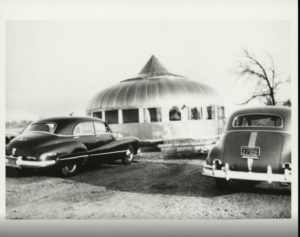 The Dymaxion House in Andover, Kansas (photo courtesy of the Henry Ford Museum)
The Dymaxion House in Andover, Kansas (photo courtesy of the Henry Ford Museum)Baldwin writes:
The house used tension suspension from a central column or mast, sold for the price of a Cadillac, and could be shipped worldwide in its own metal tube. Toward the end of WW II, Fuller attempted to create a new industry for mass-producing Dymaxion Houses.
Bucky designed a home that was heated and cooled by natural means, that made its own power, was earthquake and storm-proof, and made of permanent, engineered materials that required no periodic painting, reroofing, or other maintenance. You could easily change the floor plan as required - squeezing the bedrooms to make the living room bigger for a party, for instance.
Downdraft ventilation drew dust to the baseboards and through filters, greatly reducing the need to vacuum and dust. O-Volving Shelves required no bending; rotating closets brought the clothes to you. The Dymaxion House was to be leased, or priced like an automobile, to be paid off in five years.
Only two prototypes of the homes were produced, and both were purchased by William Graham who bastardized the original prototype. Graham’s family lived in the house for nearly 30 years. In 1990, the house was donated to the Henry Ford Museum where it is on display for tours.
The Dymaxion Deployment Unit
“Integrity is the essence of everything successful.” -Bucky
Based on the same design as the Dymaxion House, the Dymaxion Deployment Unit (DDU) was constructed of corrugated steel with wallboard, portholes, and a vented cap. Bucky was commissioned in 1942 to provide 200 DDUs to the Army Signal Corps as quickly as possible.
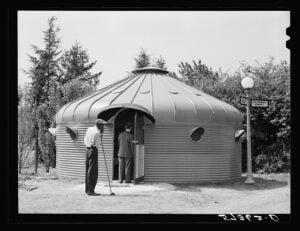 The first prototype of the DDU was unveiled in 1941 at Haynes Point Park in Washington D.C.
The first prototype of the DDU was unveiled in 1941 at Haynes Point Park in Washington D.C.
Butler Manufacturing created these military housing units and sent them all over the world. The steel shortage during WW II halted the production of any future DDU.
The Dymaxion Car
The Dymaxion Car is one of Buckminster's most futuristic designs, as he dreamed of a vehicle that could transition between land, sea, and air. He called it “Omni Medium Transport.” The Dymaxion’s aerodynamic design was meant to maximize speed and fuel efficiency. It had three wheels, rear-wheel steering, front-wheel-drive, and the engine in the rear.
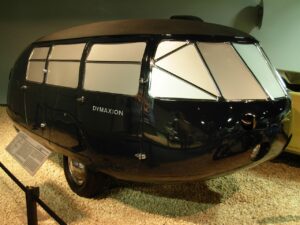 The Dymaxion Car had a V8 rear-mounted engine with a single-wheel front-wheel drive system.
The Dymaxion Car had a V8 rear-mounted engine with a single-wheel front-wheel drive system.As a gesture of goodwill, wealthy stockbroker Philip Pearson gave Bucky $5,000 to help with unemployment, along with naval architect Starling Burgess to set up shop and employ 27 people to build the prototype of the Dymaxion Car. Bucky received a patent for the car in 1937.
Three prototypes were built. Each car held up to 11 people, got 30 miles to the gallon, and reached speeds up to 90 mph. Only Prototype Two still exists, where it is on display at the National Automobile Museum in Reno, Nevada.
Though these inventions never became mass phenomenons, one of Bucky’s innovative designs did—the geodesic dome, of which there are now over 300,000 in the world.
The Geodesic Dome
“You never change things by fighting the existing reality. To change something, build a new model that makes the existing model obsolete.” -Bucky
The first dome of this nature was designed by German engineer Walther Bauersfeld, who was working for the Carl Zeiss optics company developing the first projection planetarium. He designed the dome to house the planetarium which sat on top of the Zeiss corporate headquarters.
Bucky applied for the U.S. patent on the dome in 1951 and was awarded it in 1954, but his work on creating the dome began in the mid-1940s at Black Mountain College. He continued work with the help of students at Bennington College, and the University of Oregon Architecture School.
Based on the idea of “continuous tension” as opposed to “discontinuous compression,” Bucky’s geodesic dome design is energy efficient, uses fewer building materials, affordable, maximizes interior space, and can withstand high winds and extreme temperatures.
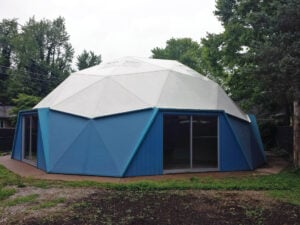 Bucky and his wife, Anne Hewlett lived in this geodesic dome house in Carbondale, IL from 1960 to 1971.
Bucky and his wife, Anne Hewlett lived in this geodesic dome house in Carbondale, IL from 1960 to 1971.Wikipedia describes the geodesic dome as “a hemispherical thin-shell structure (lattice-shell) based on a geodesic polyhedron (a convex polyhedron made from triangles). The triangular elements of the dome are structurally rigid and distribute the structural stress throughout the structure.”
Bucky’s domes were purchased by the Marines, the Ford Motor Company, and in 1964, Bucky founded Fuller & Sadao, Inc. with architect Shoji Sadao where they were commissioned to build a geodesic dome for the 1967 World’s Fair held in Montreal, Quebec, Canada,
Bucky’s Legacy
If Beck Technology had a mascot per se, it could very well be Bucky, who fully lived our core values of passion, innovation, and caring. Bucky wasn’t just a rebel, but a true embodiment of a disruptor.
Bucky was a dreamer, inventor, and freethinker whose ideas of the world and humanity and how to better the lives of everyone globally were truly ahead of their time. Did he change the world and create the spaces so that all humankind could live a better, more sustainable life without depleting the world’s resources?
Well, we’ll let Bucky answer that:
“Never forget that you are one of a kind. Never forget that if there weren't any need for you in all your uniqueness to be on this earth, you wouldn't be here in the first place. And never forget, no matter how overwhelming life's challenges and problems seem to be, that one person can make a difference in the world. In fact, it is always because of one person that all the changes that matter in the world come about. So be that one person. ”
Buckminster Fuller’s Most Notable Awards, Honors, and Acknowledgments
- 1983 Presidential Medal of Freedom, President Ronald Reagan
- 1969 Humanist of the Year, American Humanist Association
- 1960 awarded the Frank P. Brown Medal, The Franklin Institute
- 1970 elected Academician, National Academy of Design
- Received a total of 28 U.S. patents
- 1970 Gold Medal Award, American Institute of Architects
- 1976 St. Louis Literary Award, Saint Louis University Library Associates
- 1977 Golden Plate Award, American Academy of Achievement
- Received a total of 47 honorary degrees
- Authored 28 books
What are you doing to change the world?
This post is part four of our series titled “Rebels of Construction.”
What Does it Mean to be a Rebel?
Rebels challenge conventional ways of thinking, defy rules, and revolt against those that tell them ‘no.’ Without Rebels, there would be no invention, innovation, or improvement in our society. Disrupting the status quo, a true Rebel charts a new course where all benefit. In the blog series, Rebels of Construction, Beck Technology celebrates the independent spirit of the Rebel.












